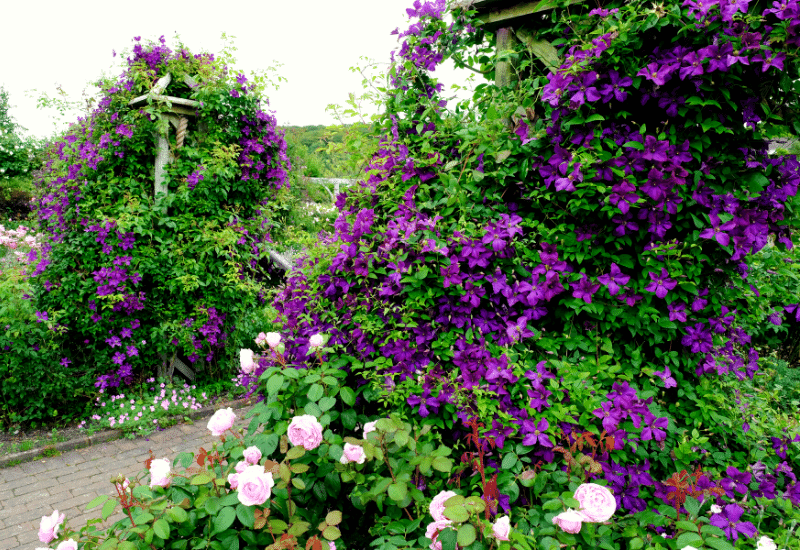
Imagine your gate, your porch, your arbor, gazebo or even your front wall graced with climbing vines with a profusion of purple flowers!
No color can give you the same luxurious and dreamy effect as this wide range of shades we get with blue and red when they mix, with lilac and violet hues in between.
Picture a romantic wisteria with drooping blooms by your entrance, or a showy clematis on a beautiful arch or trellis…
Vines or climbers with purple or lilac-colored blossoms will bring vibrant energy to your garden, whether you have a sunny property or a spot in the shade to spare…
We have compiled range of beautiful and even breathtaking annuals and perennials vines and climbers with purple blooms in varying shades for your garden; sure one will suit your needs, for soil, sunlight and even climate.
So, read on and find out their bloom time, landscaping ideas for how and where to plant them.
14 Beautiful Vines with Purple Flowers
The choice of climbing vines with purple flowers is guided by a desire for softness and appeasement within this haven of peace that your garden grants you.
Lighter, tending towards lilac to dark violet to magenta, they offer freshness and delicacy or melancholy. In the sun or in the shade, in wet or dry soil, whatever you want to shade a pergola or hide an ugly the perfect plant exists!
And now you can read and pick your own, but wait till the end because I’ve kept a real surprise for last…
Here are 14 most beautiful flowering vines with purple colored blossoms to dress up a bare wall, a fence, a pergola or a trellis.
1: Japanese Wisteria ‘Royal Purple’ (Wisteria floribunda ‘Royal Purple’)
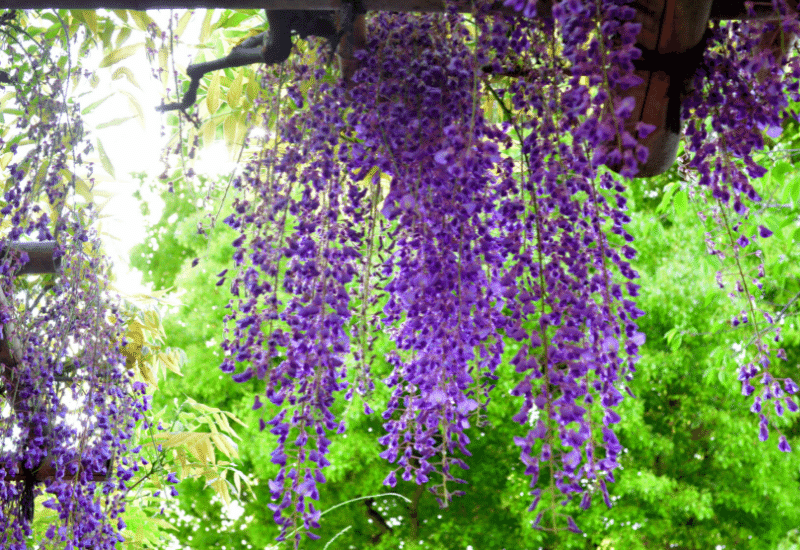
Wisteria is one of the most spectacular full-Sun flowering vines in the world, and the Japanese variety ‘Royal Purple’ is so beautiful that it has won the Award of Garden Merit by the Royal Horticultural Society.
From late spring, this elegant flowering climber fills with a sea of drooping tresses of violet purple flowers that look like those of peas, each cluster reaching 20 inches in length (50 cm).
These then turn into long pods that will decorate your garden till fall and even into the winter season. The finely textured foliage is made up of many pinnate bright green leaves, each with up to 19 leaflets, and they will turn golden yellow in late fall.
Japanese wisteria ‘Royal Purple’ is a show stopping protagonist un any garden, even in large parks.
It will be the focus of attention during its blooming season and then provide shade and texture till frost; finally, you will have its interesting twining vines for a sculptural touch in winter. It will suit any informal design, but it needs a large space.
2: Bengal Clock Vine (Thunbergia grandiflora)
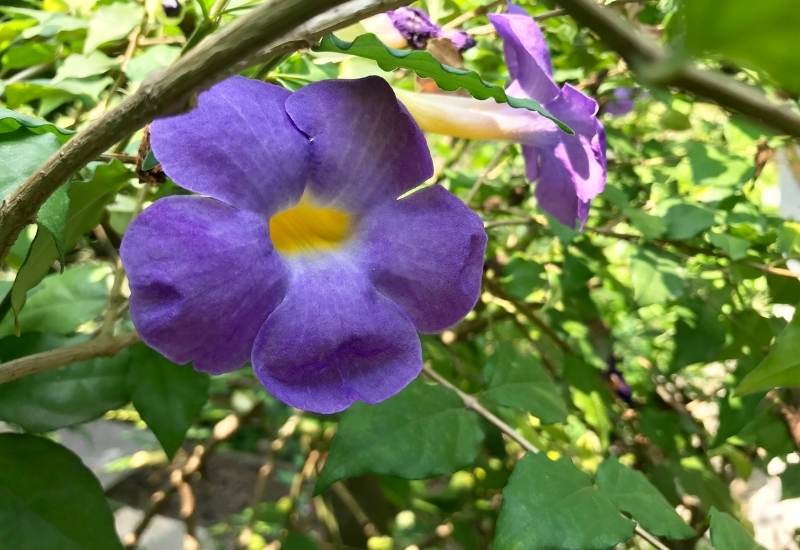
Bengal clock vine will brighten up gardens in full Sun or partial shade with showy and exotic looking flowers.
There are a few varieties with blooms that range from blue to pale lilac, with many shades of purple in between.
The blossoms are 3 inches across (8.0 cm) and with five petals that lead to a white and yellow central mouth. They may vaguely remind you of orchids, thanks to the extended lower tepal. You will have them in your garden for months, starting in summer.
The leaves are emerald green, drooping, heart shaped and big, up to 8 inches long, in fact (20 cm)! This climber too has won the Award of Garden Merit by the Royal Horticultural Society.
Bengal clock vine is perfect for a garden or even terrace in a hot region, where it can bring its eye catching flowers to your green space. It is ideal for tropical, Mediterranean and Hispanic inspired gardens, but also for gravel and urban designs.
3: ‘Amethyst’ Passion Flower (Passiflora ‘Amethyst’)
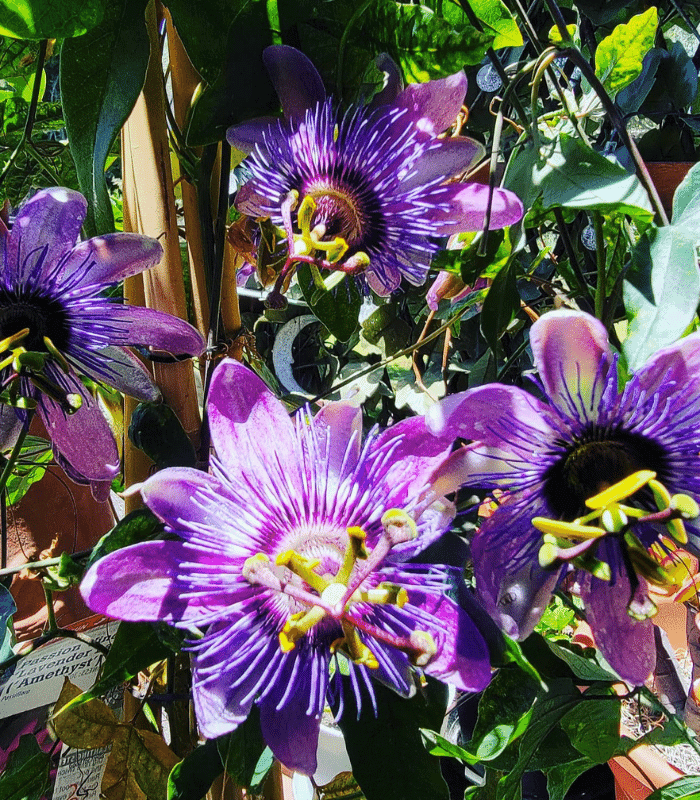
For a really extraordinary purple blooming vine, passion flower is perfect, and ‘Amethyst’ offers you one of the brightest shades of violet and magenta ever. As you know, these climbers have very complex and exotic looking blooms, with unusually shaped and colorful stamens, a “crown” of filaments and tepals that look like the rays of the Sun.
This cultivar in particular is very generous: each plant can give you up to 60 blossoms a day in fact! As they mature, the petals become reflexed (they bend backwards), changing their whole appearance.
This historical hybrid also has edible, delicious and even very healthy fruits as well! The foliage is ling, mid green and fairly sparse.
‘Amethyst’ has won the Award of Garden Merit by the Royal Horticultural Society, which makes it one of the best varieties of passion flower ever.
It needs warm climate though, but of you can, it will really make its purple flowers the protagonists on the trellises, gate, or porch of your garden. If you can’t, we have a cold hardy variety for you later on.
4: Prairie Rose (Rosa setigera)
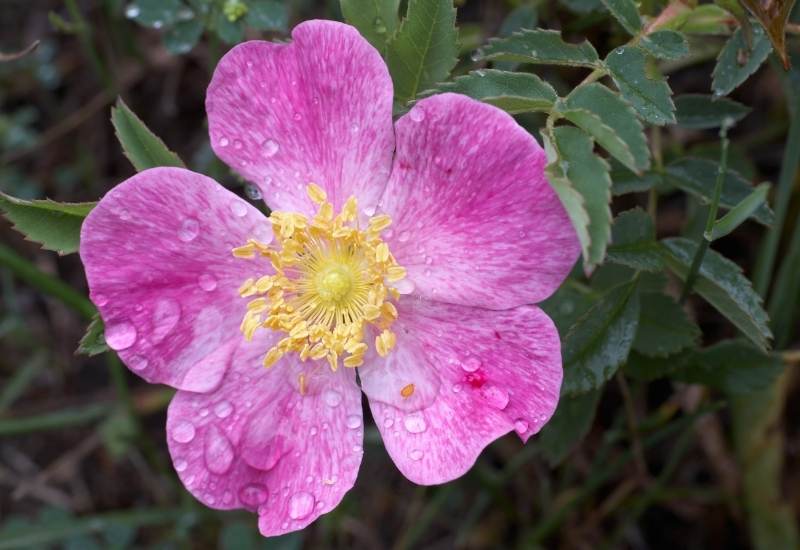
Prairie rose is a climbing and natural variety with lovely flat and single blooms that last from spring to frost. Each bloom is about 2 inches across (5.0 cm) and it has 5 petals.
These start off pastel but bright lavender purple and fade to a pale off to a very faint violet blue as they mature.
The central fluff of stamens is golden yellow and they are also mildly fragrant. The foliage is quite thick, light green and not glossy, but nicely veined, which gives it a fine texture. The hips are an attraction for birds, and they will ripen to a lovely red rose tint.
Prairie rose is the vine you want in a naturalistic or even naturalized garden; it has a beautiful wild and bushy appearance, like you would find at the ends of temperate forests by a clearing.
For this reason, it requires a fully informal setting and it’s ideal for a cottage garden; on the other hand, it is an average maintenance plant, unlike most other roses.
5: Purple Bell Vine (Rhodochiton astrosanguineus)
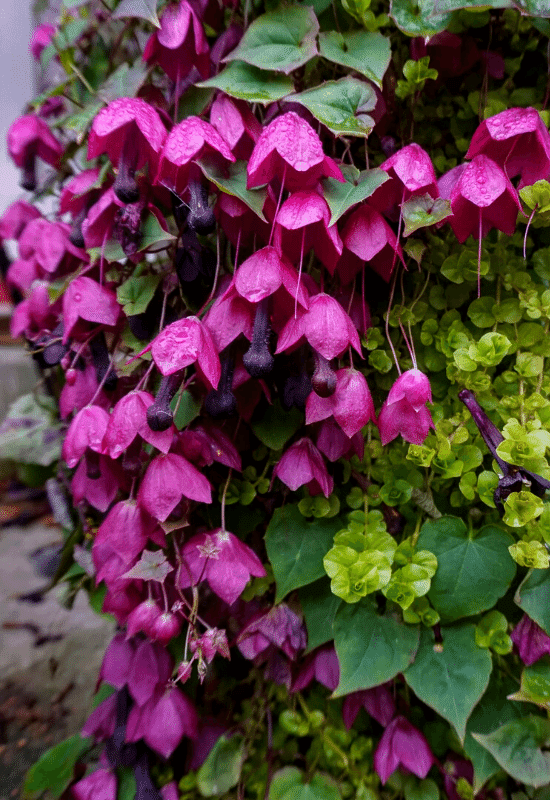
Purple bell vine is an exotic soft perennial vine and marathon bloomer, with bell shaped and nodding flowers of a bright magenta purple shade and a central tube with an extraordinary maroon color!
They come in large numbers throughout the season, and they will change after pollination, turning rose red, but they will still keep on the plant for weeks after that!
The leaves are cordate (heart shaped), 3 inches long (8.0 cm) and they too have a touch of purple on their edges. Grown as a perennial in hot climates, you can easily have it as an annual in colder regions, as it will blossom profusely in its first year.
It too has won the Award of Garden Merit by the Royal Horticultural Society.
Purple bell flower will definitely add a touch of exotic elegance and long lasting brightness to any informal garden, from exotic to temperate in inspiration. It is also an easy to grow and low maintenance vine.
6: ‘Ben Jammin’ Fuchsia (Fuchisa ‘Ben Jammin’)
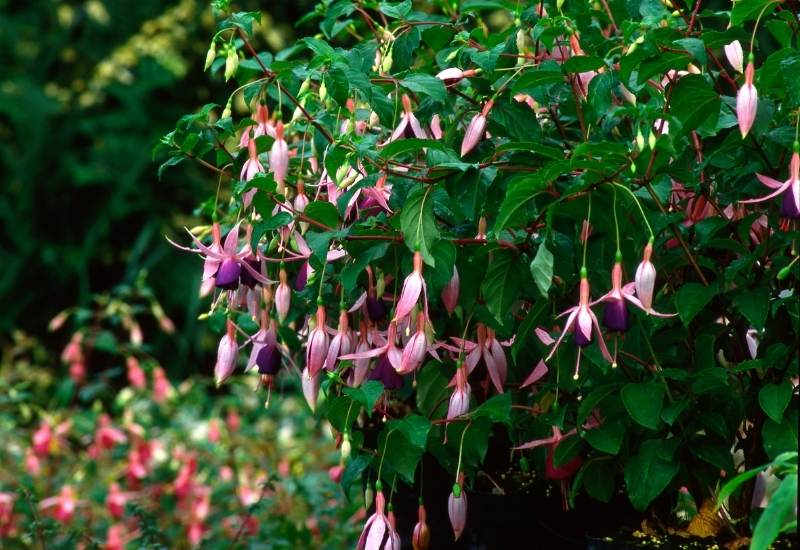
Fuchsias are not technically vines, but you can train them to climb, and this practice is becoming more and more popular.
Add the fact that these nodding flowers have a huge range of purples, and you get the perfect solution for your garden.
We picked ‘Ben Jammin’ for a small shrub to train as an example because it is fully purple, with lovely rich velvet purple crowns, a hue which is then taken up by the long pistil and stamens which extend far beyond the petals.
The outer tepals curl back beautifully and they are bright magenta on the lower side and with a paler version of the same tint on the upper side.
The fine, mid green and elliptical foliage on purple stems completes the fresh but bright effect with harmony.
There are many other varieties you can grow and train as vines, like the striking red and deep purple ‘Dark Eyes’ with large blooms, or the white and violet purple with a short and barrel shape round crown ‘La Campanella’. All are suitable for informal gardens.
7: Purple Wreath Vine (Petrea volubilis)
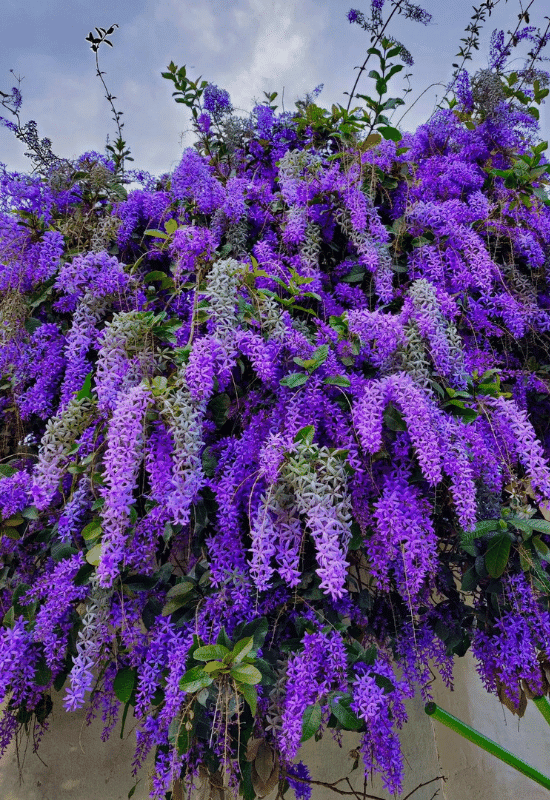
Purple wreath vine is a tropical plant from Central and South America with long racemose inflorescences that hang from the branches, up to 8 inches (20 cm).
These are made up of violet purple flowers with five star shaped back petals and then 5 round ones in the middle of a deeper and more saturated shade and with the lower two joined; very original indeed!
But this is not all, it is really so generous that the whole shrub becomes a ceiling, or a cloud of beautiful blossoms!
The leaves are mid to dark green, oblong and elliptical as well as large, up to 6 inches long (15 cm).
This exotic vine us less well known than others, so, if you want to show off your expertise, or if you want to surprise your guests, it may just be the right choice.
8: ‘Cupani’ Sweet Pea (Lathyrus odoratus ‘Cupani’)
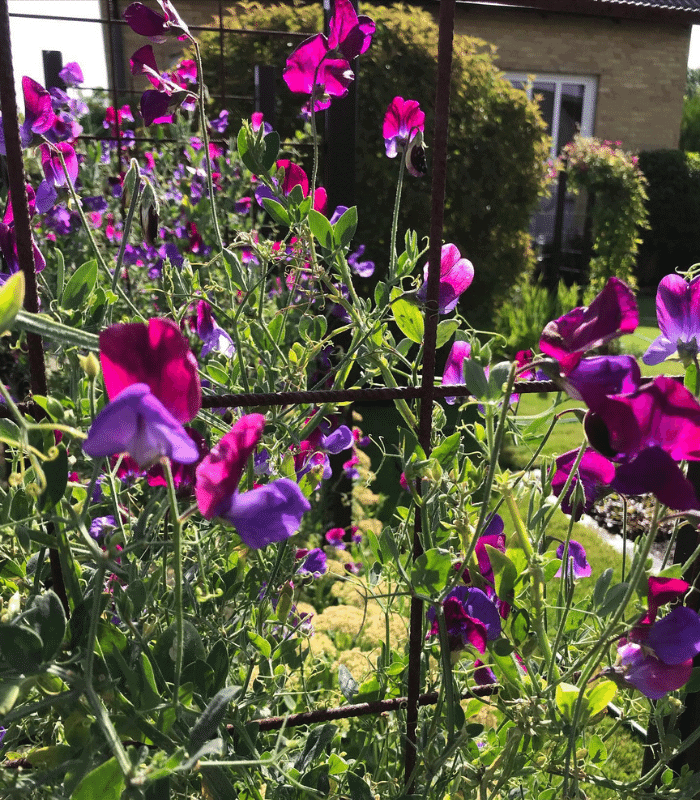
Sweet peas are annual climbers with amazing blooms, and ‘Cupani’ has two amazingly vibrant colors: the upper tepals, the “banner” are dark magenta to jam purple, while the lower part (the “wing” and “keel”) is iris purple violet: what a spectacle.
They will come in huge numbers from spring to frost, and the bright green, fresh looking foliage will give you the perfect backdrop for this display.
What is more, this is one of the most fragrant varieties of Lathyrus, and an heirloom one to boot, discovered back in 1695 by the Franciscan monk that gave it his name.
‘Cupani, sweet pea is ideal for walls, trellises, fences and gates especially if you want purple and you live in a cool region, including virtually the whole of Canada, thanks to its resistance to cold, and it’s super easy maintenance.
9: Bush Clock Vine (Thunbergia eracta)
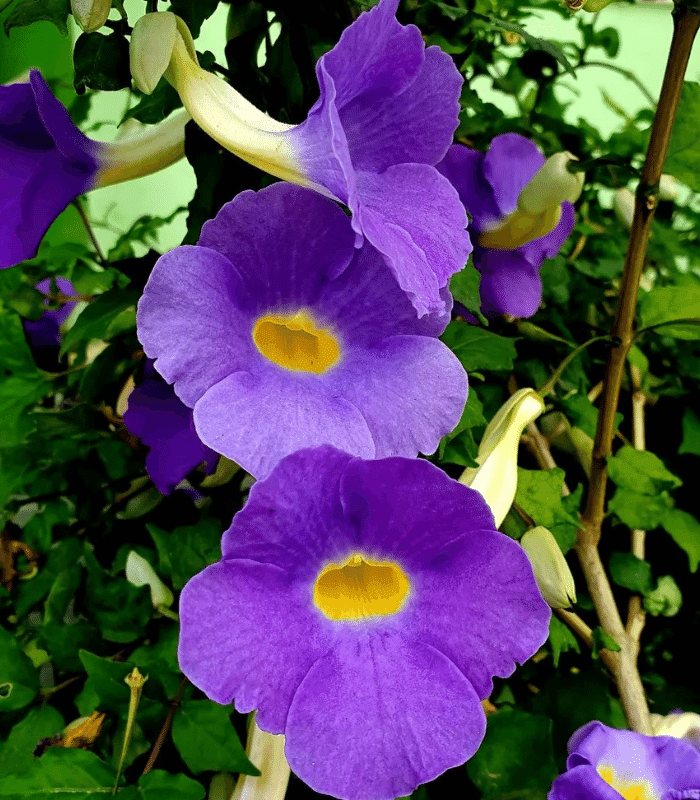
Bush clock vibe is a close relative of Bengal clock vine, but its flowers have a much richer and deeper shade of purple violet.
The mouths remain golden yellow, and the back of the flower, that looks like a hood, is white. But the tepals pack in so much color that they really stand out. They are small, about 1-inch-long (2.5 cm) but full of energy.
The bright green foliage is less exotic than on its sister, but dense and perfect to set off the amazing blooms. It also has a more spreading habit than Thunbergia grandiflora.
Bush clock flower is suitable to natural looking and even naturalized gardens, on fences, trellises and even to soften walls, but it is not cold hardy. Then again, it is a plant that requires very little care, so you can get long blooms from summer to the end of fall with little work.
10: ‘Kniola’s’ Morning Glory (Ipomoea purpurea ‘Kniolas Black’)
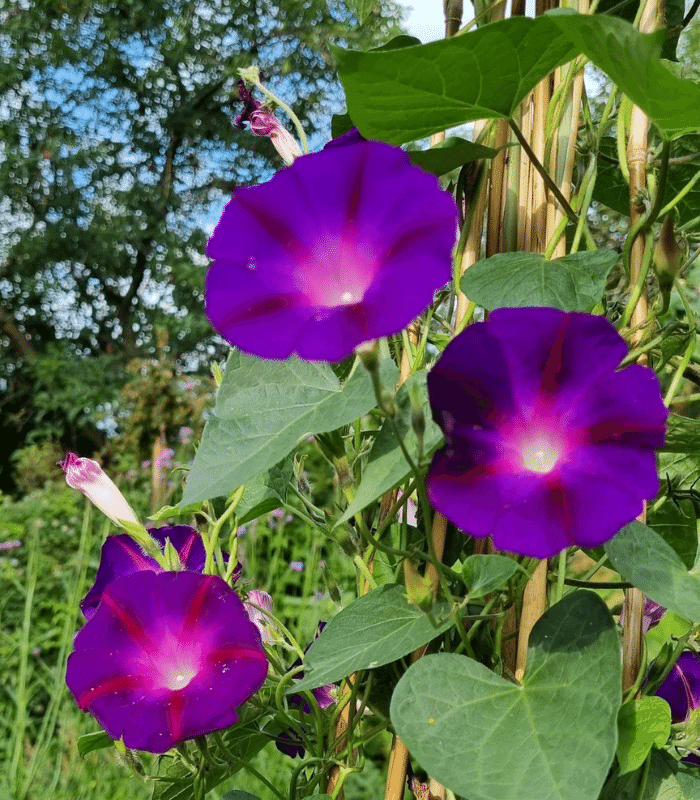
Morning glory is a star vine among annuals, with large trumpet shaped flowers that can reach 3 inches across (8.0 cm). These range in color from violet purple to light blue, and there are even magenta varieties.
‘Kniola’s’ is the cultivar with the most impressive coloring; deep velvet purple with violet undertones and jam to plum purple rays that leaf you to a bright lime to canary yellow center!
These showy blooms will open daily on the lush mid green heart shaped foliage from summer to fall. It will also attract hordes of butterflies and pollinators, as well as a few hummingbirds.
‘Kniola’s’ morning glory is ideal for all informal gardens, even in very cold regions; it is a perennial by nature but in most temperate region it is treated as an annual, because it is fast growing and it will reach maximum height in a matter of a few months.
11: ‘Rosemoor’ Early Large Flowering Clematis (Clematis ‘Rosemoor’)
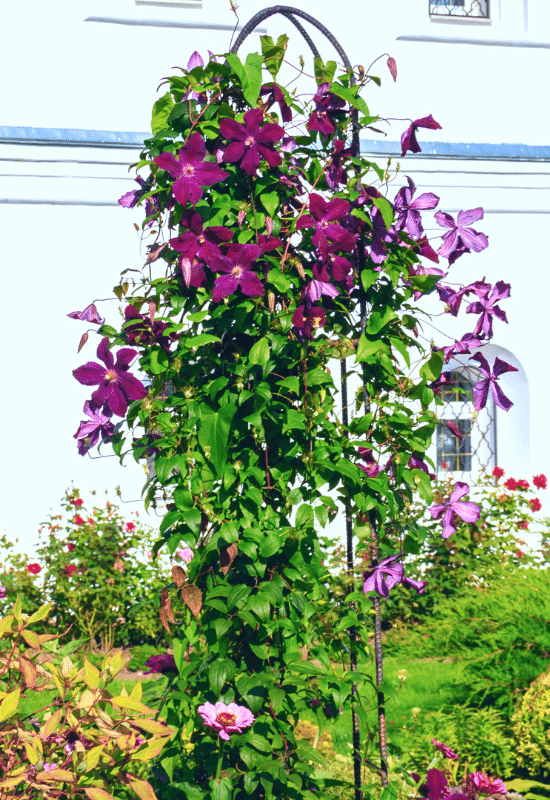
There are many varieties of clematis with flowers in different shades of purple, but if you want a color perfect vine, ‘Rosemoor’ is your plant! It has large, star shaped blooms that reach 6 inches across. The petals are broad, with a velvety texture and they are pure rich and bright purple.
You will not find any with a tint that better describes this color. The central part has canary yellow anthers on white pistils, drawing your eyes in.
Clematis ‘Rosemoor‘ is a shade-loving flowering climber, blooms flower for a long time, from spring to early autumn.
So you will have this vivid display virtually throughout the season. It also has bright and light green leaves, fairly dense on the vine, that make the ideal backdrop for it.
You can grow ‘Rosemoor’ early large flowering clematis in most gardens even if you do not have a full Sun position to offer.
It is even suitable for containers, so, you could even have it to divide your terrace from your neighbor’s with an elegant and brightly colored trellis.
12: Purple passionflower (Passiflora incarnata)
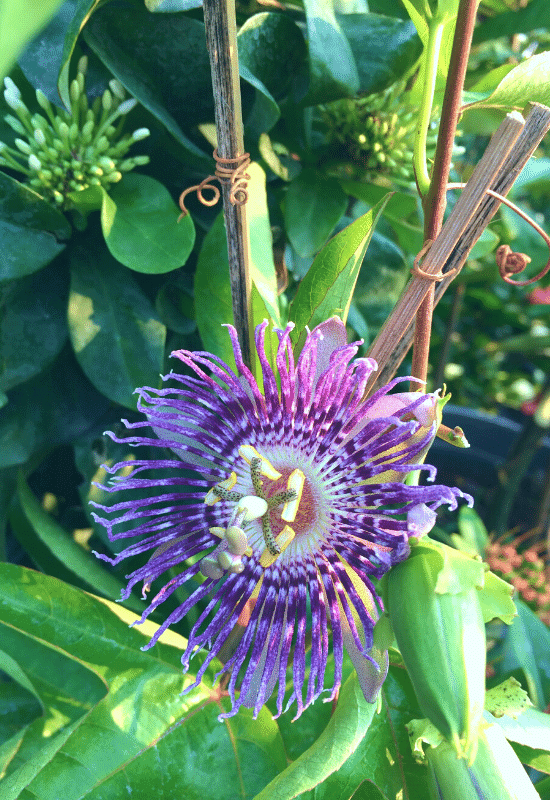
Wild passion flower is another variety of this vine with a big purple theme in its blooms. The outer petals are shiny and magenta violet in shade, and they will open up then bend backwards. But this passion flower is famous for the filaments it displays.
They start with a very bright and deep magenta shade, then they have a thin white ring, then they turn deep violet and then finally lavender.
What is more, they bend and curve, giving you a unique effect. All is topped with spectacular lime yellow anthers on arching postils and lime green stigma on arching pistils!
Of course, you will also get the dark green, exotic looking three lobed leaves too. And don’t forget to eat the exquisite fruits when they ripen!
Wild passion flower is a favorite vine with purple flowers all over the world. It is a show stopper that adapts even to fairly cool climates, so you can have a climber with exotic flowers climbing on your pergola or fence even if you do not love in Flory or California!
13: ‘Purple Queen’ Bougainvillea (Bougainvillea ‘Purple Queen’)
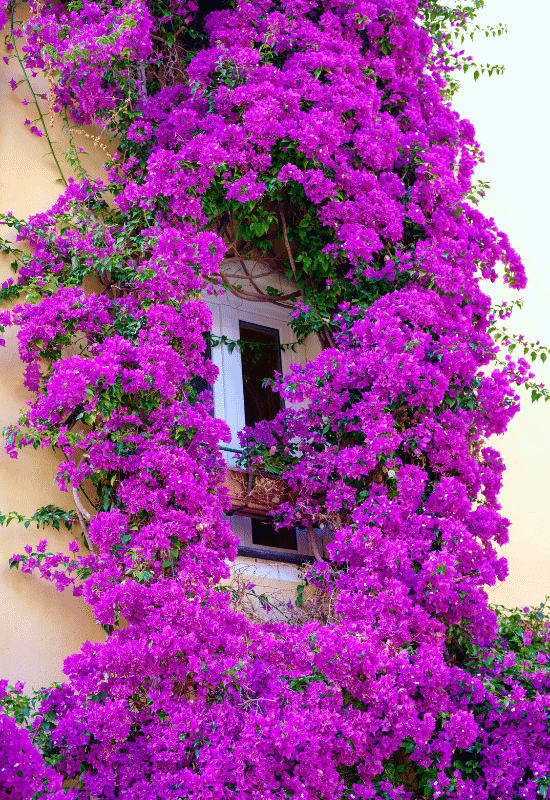
Bougainvillea is a strong and vigorous vine with a massive color display, and ‘Purple Queen’ has the purest shade of our color ever.
Actually, the color comes from the three bracts that frame the small, cream flower, but we all know them for their massive blooms, that cover whole walls with whites, oranges, pinks, reds and, in our case, purple.
It is a common sight all around the Mediterranean, where it blooms repeatedly in all four seasons! The lush, lush, thick and mid green foliage will cover any gaps when the climber is resting.
It is very low maintenance and a fast grower, which makes it ideal to flood walls, gates and even whole buildings with its bright and generous displays.
If you choose ‘Purple Queen’ bougainvillea, make sure you give it plenty of space; this is not the small vine to grow on a tiny porch or gate; it is perfect for large scale solutions, in fact you can even find it coasting whole streets in sunny Mediterranean regions, and yes, it will bring to your yard the atmosphere of that sunny and iconic sea.
14: Brazilian Dutchman’s Pipe (Aristolochia gigantea)
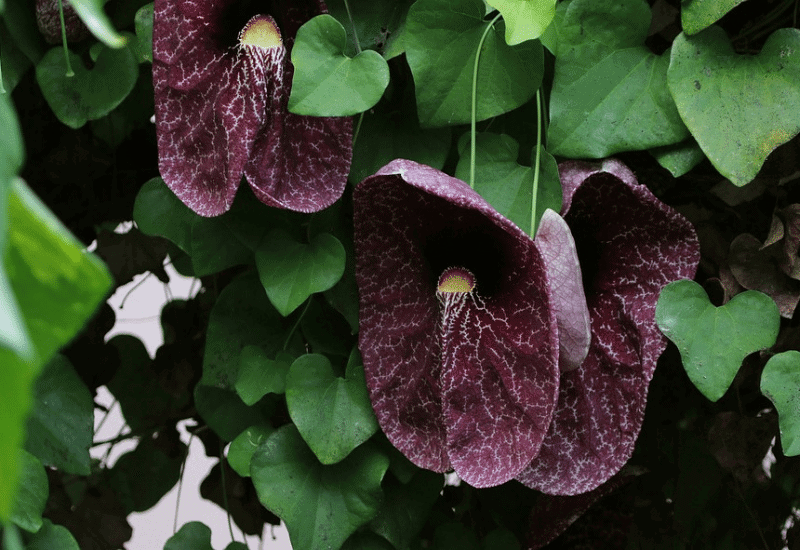
We kept giant Dutchman’s pipe, a.k.a. pelican flower, as our last vine with purple flowers to close our selection with an unforgettable bang! OK what we love in this tropical climber is not actually the flowers, but the modified leaves they use to eat insects.
Yes, because Aristolochia must be the most spectacular carnivorous plant in the whole world! These are broad, large and they look like massive beefsteaks, up to 1-foot-wide and long (30 cm).
They are of an amazing, intense, bright pure purple shade, with a pattern of light and pastel magenta lines that look like very elegant and artistic embroidery on velvet. As you approach the mouth, it all becomes darker, with an impressive deep shade of burgundy and no more patterns.
Then it suddenly turns bright orange, bright yellow and then white as you enter the “stomach” (pitcher) of this plant. It looks like bright fire!
The foliage is mid green, broad and very lush, which completes the exotic look of this surreal vine.
Brazilian Dutchman’s pipe is like a crown jewel for any garden; for sure it will become a topic of conversation with friends and guests. Surely, this exotic beauty will make you into the talk of the town among gardeners…
Purple Flowering Climbers for All Gardens and All Seasons
How many purple beauties have we met? I find it hard to name my favorite, but I must say that my jaw drops every time I see a Brazilian Dutchman’s pipe, and how about your pick?

Written By
Amber Noyes
Amber Noyes was born and raised in a suburban California town, San Mateo. She holds a master’s degree in horticulture from the University of California as well as a BS in Biology from the University of San Francisco. With experience working on an organic farm, water conservation research, farmers’ markets, and plant nursery, she understands what makes plants thrive and how we can better understand the connection between microclimate and plant health. When she’s not on the land, Amber loves informing people of new ideas/things related to gardening, especially organic gardening, houseplants, and growing plants in a small space.
